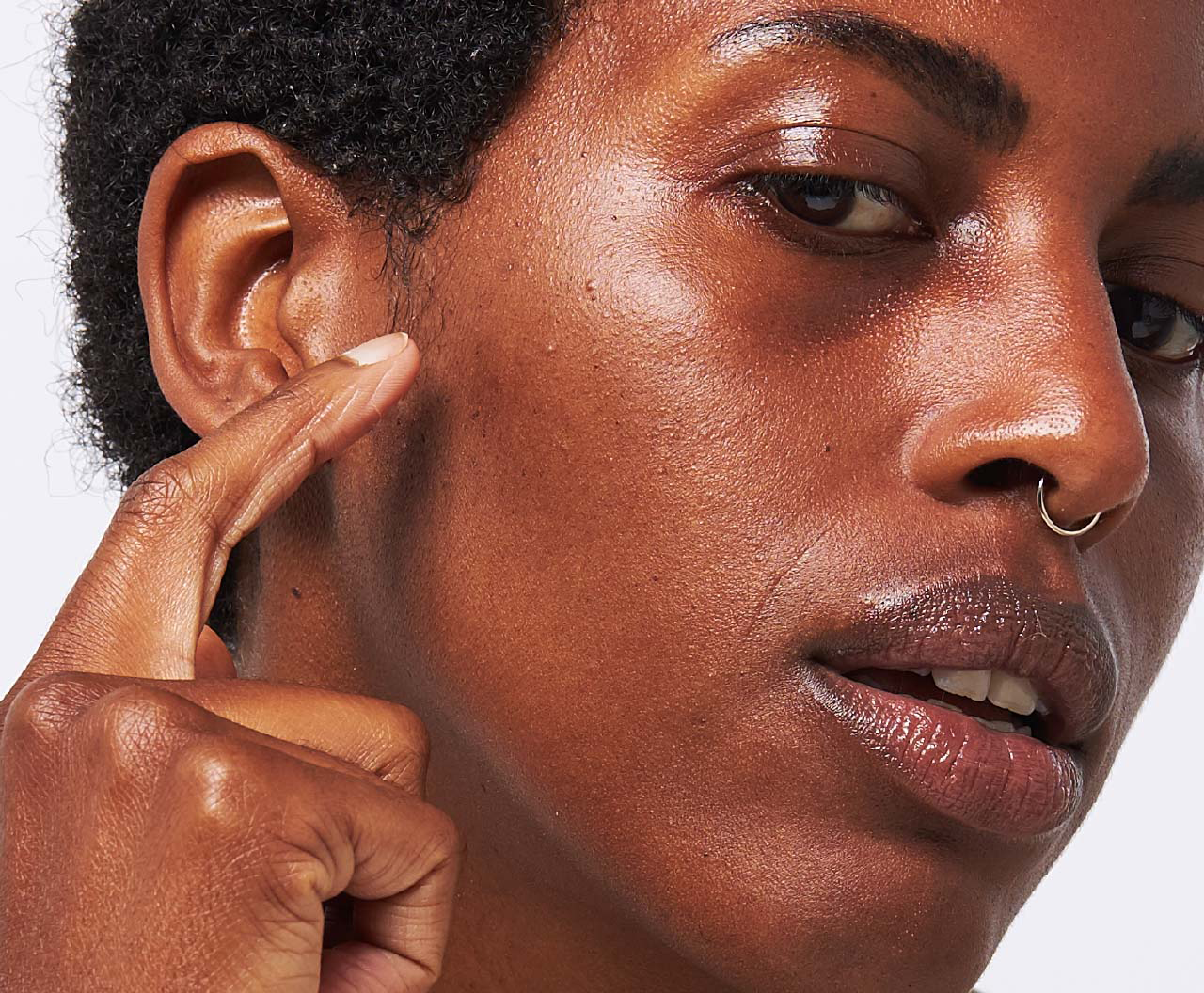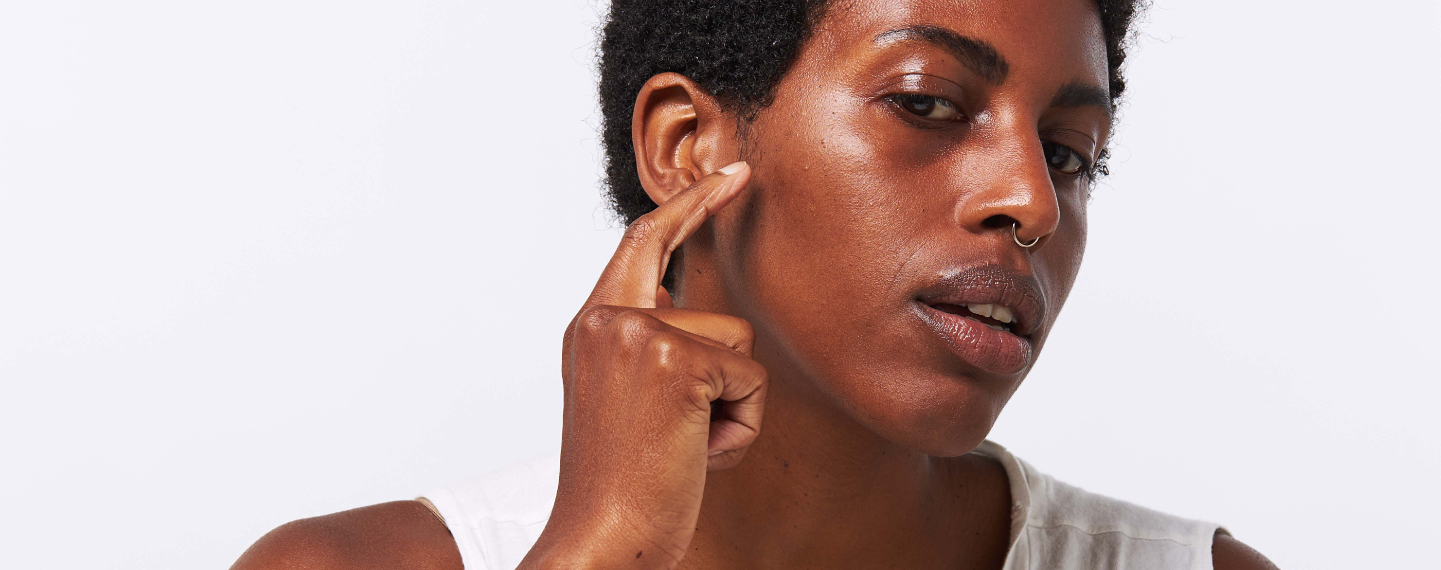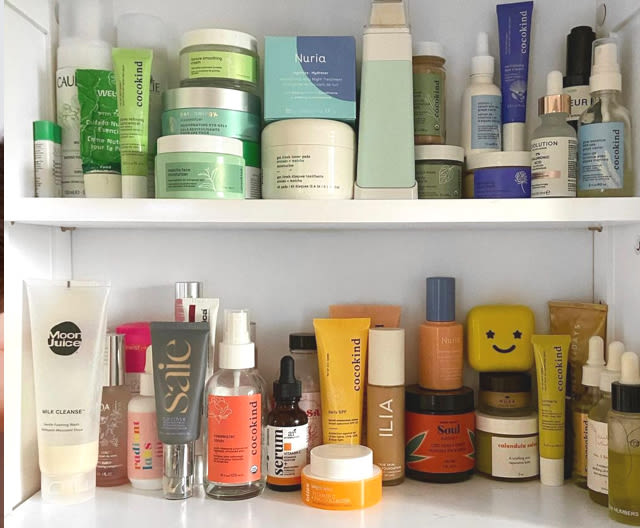Education
Why do I have acne?


SHARE
Education
Why do I have acne?
Medically reviewed by Kristin Hall, FNP
Written by Apostrophe Team
Last updated 4/1/2024
If you’re like many women, the sight of a growing pustule on your face can invoke an emotional reaction. You’re not 15 anymore, so why is acne running (and ruining) your life? Let’s explore what acne actually is, the potential causes, and treatment options to help you get that zit or breakout under control.
What Is Acne?
Acne is a skin disorder that causes outbreaks of skin lesions — also known as pimples. Acne is caused by the oil glands in your skin producing too much sebum (a sticky, oily substance) which clogs pores. Acne can also be caused by the overproduction of the bacteria P. acnes (now called C. acnes).
Pimples mostly occur on the face, neck, back, chest, and shoulders, because these are areas of the skin that have the highest concentration of oil glands. Acne is not a serious health threat, though severe acne can lead to permanent scarring.
What Causes Acne?
The four factors that directly contribute to acne are: excess oil production, pores becoming clogged by “sticky” dead skin cells, bacteria, and inflammation.
Some other factors that play a role in the development of acne can include:
Systemic conditions
Acne can be a window into a systemic condition. For example, changes in hair growth or loss, irregular menstrual cycles, rapid weight changes, and rapid onset of acne with no prior history of acne, can all be indicative of an underlying disease, such as polycystic ovarian syndrome (PCOS), or another endocrine disorder.
Hormonal changes
During puberty, girls have an increase in male sex hormones called androgens. This increase can cause the oil glands to get larger and produce more sebum, clogging pores and causing breakouts.
As girls mature into women, menstruation is one of the most common acne triggers. Pimples tend to form a few days before the cycle begins and go away after the cycle is completed.
Other hormonal changes, such as pregnancy and menopause, can either improve acne or make it worse. Stopping the use of hormonal birth control medication can play a role as well.
Medications
Certain meds, such as those used to treat epilepsy and types of depression, can contribute to acne. Corticosteroids, anabolic steroids, and lithium can also cause acne.
Makeup and skincare
Oil added to makeup and skincare products can worsen acne. When purchasing cosmetic and skincare products, always look for the terms “non-comedogenic,” “oil-free,” or “won’t clog pores.”
Family history
If other family members have acne, there is a greater chance you will have it as well. In a study conducted on twins, research suggested a strong genetic basis for acne.
Diet
Your diet can influence inflammation throughout the body. One meta-analysis of 14 observational studies that included nearly 80,000 children, adolescents, and young adults showed a link between dairy products and increased risk of acne.
Some studies have also linked high-glycemic-index foods and acne. Research suggests that a high-glycemic diet may play a role in the development of acne.
How to Prevent Breakouts
Like most things in life, acne is not always completely in your control. However, here are some tips to help prevent breakouts:
Always take your makeup off before bed.
Avoid heavy facial oils and hair products that contain oil.
Some acne spots are not actually acne but are scars from previous acne lesions or from picking at pimples. Wear sunscreen with SPF 30+ every day to prevent darkening of these spots.
Treatment Options for Acne
Treatment options will vary based on the type of acne you have — from mild to severe.
Mild acne
Mild acne can consist of whiteheads, blackheads, and small pustules, and there are many at-home treatments for it. To start, get in the habit of washing your face twice per day with warm water and a gentle cleanser or soap.
You can also try an over-the-counter lotion or cream containing benzoyl peroxide, salicylic acid, sulfur, or resorcinol. Benzoyl peroxide works to reduce sebum made by the oil glands. Resorcinol, salicylic acid, and sulfur help breakdown whiteheads and blackheads. These ingredients may dry out your skin if you use them too much, so be sure to follow the directions.
Moderate to moderately severe acne
This type of acne consists of many whiteheads, blackheads, papules, and pustules that cover from 25 percent to 75 percent of the face and/or other parts of the body.
A dermatologist can treat this type of acne with antibiotic lotions, gels, and retinoic acid or retinol. Retinoic acid is an altered form of vitamin A that helps prevent whiteheads and blackheads from forming.
Topical tretinoin, which works by turning over skin cells faster to prevent clogged pores, is a mainstay in any moderate acne treatment regimen, and has the added bonus of treating fine wrinkles and evening and brightening skin tone.

PRESCRIPTION TRETINOIN
Target acne, dark spots, and signs of aging with this science-backed ingredient.
Your dermatologist may also prescribe an antibiotic pill, such as erythromycin. Retinoic acid and antibiotic pills can also make your skin sensitive to the sun, so wear sunscreen and stay in the shade while using them.
Severe acne
Severe acne consists of deep cysts, redness, swelling, extreme damage to the skin, and scarring. You should see a dermatologist to care for this type of acne, as they can prescribe oral antibiotics and oral contraceptives. They can also treat large inflamed cysts with an injection of a drug that lessens the redness, swelling and irritation, and promotes healing.
Your dermatologist may prescribe isotretinoin if other treatments have not worked. Isotretinoin is taken orally and is the closest thing to a “cure” for acne that exists. Women who can become pregnant need to take special precautions when taking isotretinoin, as it can cause significant harm to the fetus.
Some large cysts that do not respond to medication may need to be drained or removed. You should never try to drain or remove your acne by squeezing or picking — your dermatologist is the only person who should drain or remove these. Trying to squeeze a cyst can lead to infection, worsen your acne, and cause scarring.
For women who break out mainly around their menstrual cycle, some birth control pills can help. Research shows that these pills can clear acne by slowing down overactive oil glands in the skin.
Sometimes, birth control pills are used along with a medication called spironolactone to treat adult acne. The hormone androgen stimulates the skin's oil glands, so spironolactone lowers levels of androgen in females. When other acne treatments aren’t working for you, spironolactone can effectively treat deep, tender acne on the lower face, jawline, or neck. Side effects of this drug include irregular menstruation, breast tenderness, headache, and fatigue.
Takeaways
Gentle, non-irritating skin care products are important for anyone with acne. Choose products that are safe for skin with acne, and eliminate products that are harsh and can make matters worse. It’s also important not to squeeze or pick at pimples, as that can worsen discoloration and scarring.
If you’re suffering from moderate to severe acne, speak with a dermatology provider to determine the treatment options that are right for you.
References
Matin T, Goodman MB. Benzoyl Peroxide. [Updated 2020 Nov 24]. In: StatPearls [Internet]. Treasure Island (FL): StatPearls Publishing; 2021 Jan-. Available from: https://www.ncbi.nlm.nih.gov/books/NBK537220/ |
Decker, A., & Graber, E. M. (2012). Over-the-counter Acne Treatments: A Review. The Journal of clinical and aesthetic dermatology, 5(5), 32–40. |
Acne (2012). Retrieved from https://www.womenshealth.gov/a-z-topics/acne |
Gainder, S., & Sharma, B. (2019). Update on Management of Polycystic Ovarian Syndrome for Dermatologists. Indian dermatology online journal, 10(2), pp. 97–105. Retrieved from https://www.ncbi.nlm.nih.gov/pmc/articles/PMC6434760/ |
Sutaria AH, Masood S, Schlessinger J. Acne Vulgaris. [Updated 2020 Aug 8]. In: StatPearls [Internet]. Treasure Island (FL): StatPearls Publishing; 2021 Jan-. Available from: https://www.ncbi.nlm.nih.gov/books/NBK459173/ |
Purdy, S., & de Berker, D. (2006). Acne. BMJ (Clinical research ed.), 333(7575), pp. 949–953. Retrieved from https://pubmed.ncbi.nlm.nih.gov/17082546/ |
Bataille, V., Sneider, H., MacGregor, A. J., & Sasieni, P. (2002). The influence of environmental factors in the pathogenesis of acne: A twin study of acne in women. Journal of investigative dermatology, 119(6), pp. 1317–1322. Retrieved from https://pubmed.ncbi.nlm.nih.gov/12485434/ |
Juhl, C. R., Bergholdt, H., Miller, I. M., Jemec, G., Kanters, J. K., & Ellervik, C. (2018). Dairy Intake and Acne Vulgaris: A Systematic Review and Meta-Analysis of 78,529 Children, Adolescents, and Young Adults. Nutrients, 10(8), pp. 1049. Retrieved from https://pubmed.ncbi.nlm.nih.gov/30096883/ |
Smith, R. N., Mann, N. J., Braue, A., Mäkeläinen, H., & Varigos, G. A. (2007). A low-glycemic-load diet improves symptoms in acne vulgaris patients: a randomized controlled trial. The American journal of clinical nutrition, 86(1), pp. 107–115. Retrieved from https://pubmed.ncbi.nlm.nih.gov/17616769/ |
American Academy of Dermatology Association. (n.d.). ACNE: TIPS FOR MANAGING. https://www.aad.org/public/diseases/acne/skin-care/tips |
Leyden, J., Stein-Gold, L., & Weiss, J. (2017). Why Topical Retinoids Are Mainstay of Therapy for Acne. Dermatology and therapy, 7(3), pp. 293–304. Retrieved from https://www.ncbi.nlm.nih.gov/pmc/articles/PMC5574737/ |
Tolleson, W. H., Cherng, S. H., Xia, Q., Boudreau, M., Yin, J. J., Wamer, W. G., Howard, P. C., Yu, H., & Fu, P. P. (2005). Photodecomposition and phototoxicity of natural retinoids. International journal of environmental research and public health, 2(1), pp. 147–155. Retrieved from https://www.ncbi.nlm.nih.gov/pmc/articles/PMC3814709/ |
Layton A. (2009). The use of isotretinoin in acne. Dermato-endocrinology, 1(3), 162–169. Retrieved from https://www.ncbi.nlm.nih.gov/pmc/articles/PMC2835909/ |
Trivedi, M. K., Shinkai, K., & Murase, J. E. (2017). A Review of hormone-based therapies to treat adult acne vulgaris in women. International journal of womens dermatology, 3(1), 44–52.
Retrieved from: https://www.ncbi.nlm.nih.gov/pmc/articles/PMC5419026/ |
Stubborn acne? Hormonal therapy may help (n.d.). Retrieved from https://www.aad.org/public/diseases/acne/derm-treat/hormonal-therapy
Shop this post

Tretinoin
Like what you just read? Sign up for our email list to get the scoop on skincare science delivered straight to your inbox.

Education
What is milia?
What is milia? Today, we’re jumping into one type of bump that you may have heard about most commonly in infants — milia.
Read More
Education
Best moisturizer for acne-prone skin
If you have combination acne-prone skin, figuring out which moisturizer is best for your skin might be tough. In this guide, we break down the best moisturizer for combination, acne-prone skin.
Read More
Education
How to build a face care routine
As you get into skincare, it might seem overwhelming, especially trying to figure out the order you're supposed to apply products in. Below, we detail how to build a face care routine for your skin!
Read More